The Gooi Steam Tram and NBM
Until well into the 19th century, the Gooi region was an isolated area, and traveling from places like Amsterdam was a costly and time-consuming undertaking: on foot, horseback, by boat, or by carriage. Accessibility to the Gooi region was greatly improved by the construction of the Oosterspoorweg (Eastern Railway) in 1874. The train connection ran from Amsterdam to Hilversum and took approximately 32 minutes. Only the areas surrounding the stations were now easily accessible, but not the surrounding towns. This changed with the arrival of tram lines that served the region.
On December 17, 1880, the establishment of the "N.V. Gooische Stoomtram" (Gooische Steamtram Company) was finally signed.
The head office was located at Middenweg 65 in Amsterdam. The building still stands today, with the inscription "Anno Gooische Stoomtram 1881" on its facade.
Office at Middenweg 65 in Amsterdam (photo 2015)
As early as May 17, 1881, the 4.7 km Amsterdam-Watergraafsmeer-Diemerbrug line was officially opened. The line was then extended to Muiderberg, which seaside resort was reached on July 22; the track length was then 16 km.
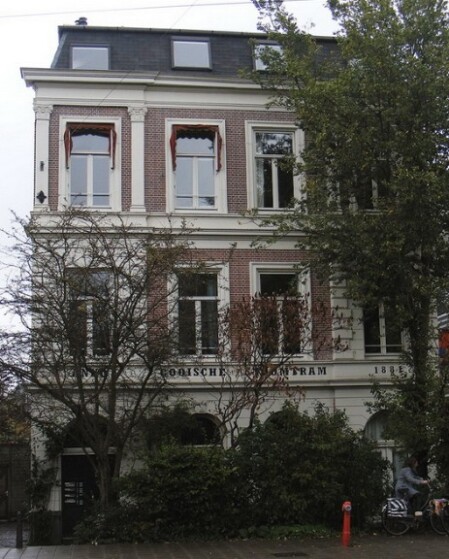
A month later, the next 5 km section was completed, namely Hakkelaarsbrug-Naarden, which opened to passenger traffic on August 20, so that the fortified town of Naarden now also had a direct connection to Amsterdam.
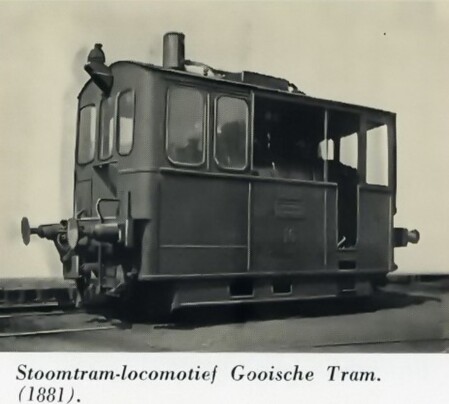
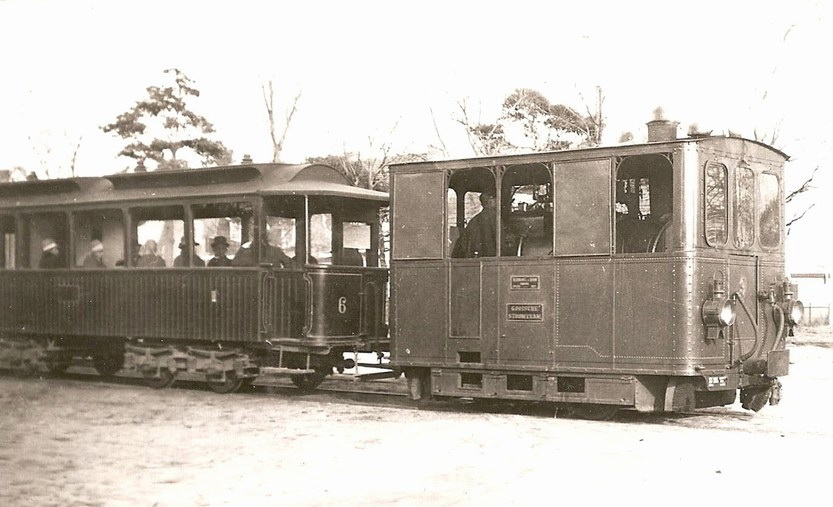
Due to the unwillingness of Huizen residents, the section to Huizen was abandoned. The track ran directly to Laren via the inn "Jan Tabak" and Crailoo, and a tram station was built on the Brink, a square in Laren. A branch line was also constructed, connecting the villages of Huizen, Blaricum, and Laren with Hilversum.
The official opening of these latter sections coincided with the Naarden-Laren section on April 15, 1882. A year later, the concession for the line from Naarden to Huizen was transferred to the new "Stoomtram Bussum-Huizen," which was established in Amsterdam on February 16, 1883. Thus, two lines were in operation:
Amsterdam-Weesperpoort to Naarden (1881-1939) and from there to Laren (1882-1942)
from Hilversum via Laren and Blaricum to Huizen (1882-1947)
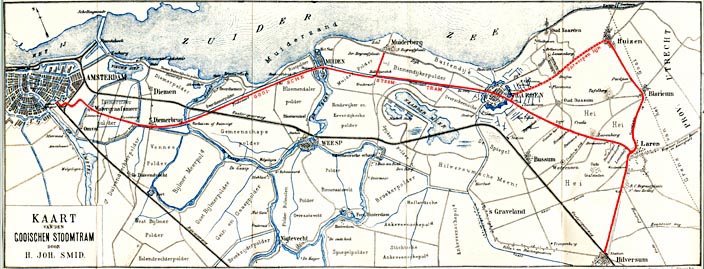
The route of the latter line was as follows:
- Oosterspoorplein, Hilversum
- Laarderweg (now Larenseweg)
- Erfgooiersplein (now Den Uylplein)
- Hilversumseweg, Laren
- Stationsweg (now Burg. van Nispen van Sevenaerstraat)
- Brink Laren
- Torenlaan Laren
- Torenlaan Blaricum
- Huizerweg
- Huizerhoogt
- Blaricummerstraat
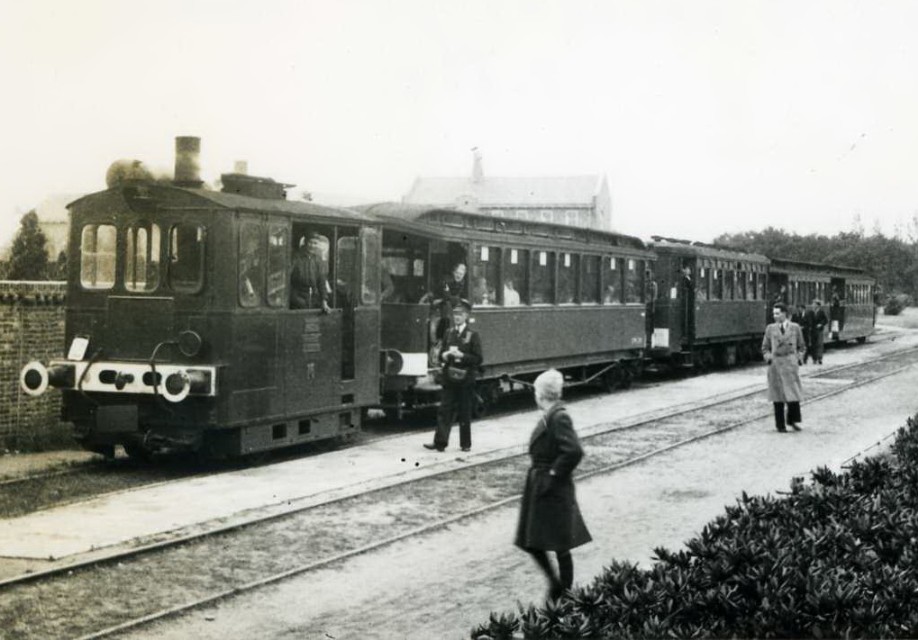
The connection consisted of a single track with switching points at several points. The railway line was on or directly adjacent to a public road, meaning the tram had to share the road with other traffic and pedestrians.
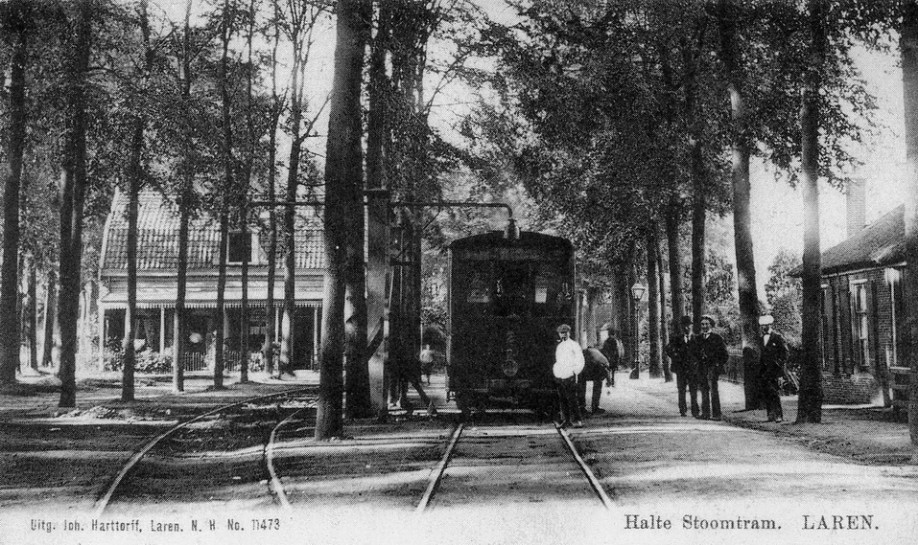
Steam tram stop in Laren
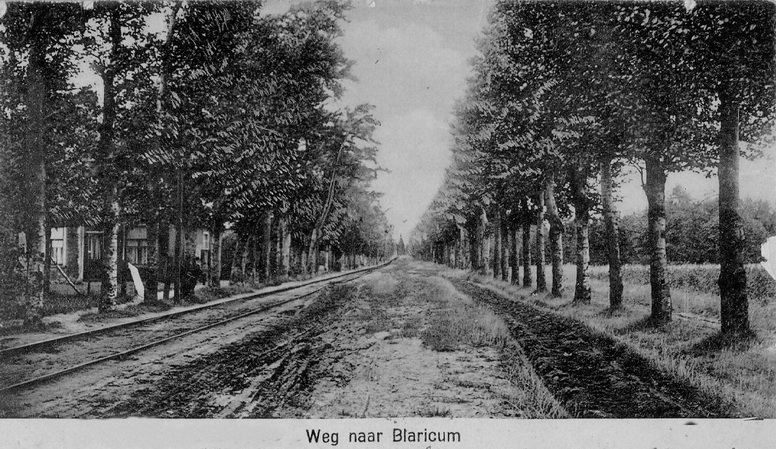
The still unpaved Torenlaan around 1900 on the border with Laren. The railway line is on the left side of the road looking towards Blaricum.
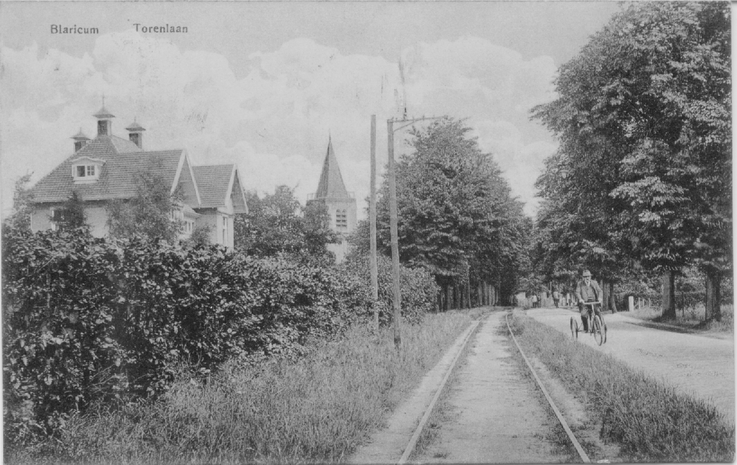
Torenlaan around 1900 with the Reformed Church in the background.
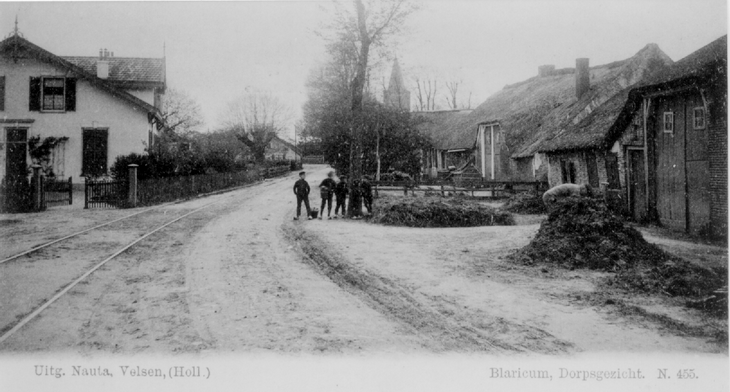
The centre of Blaricum in 1903. On the right is Mill's garage.
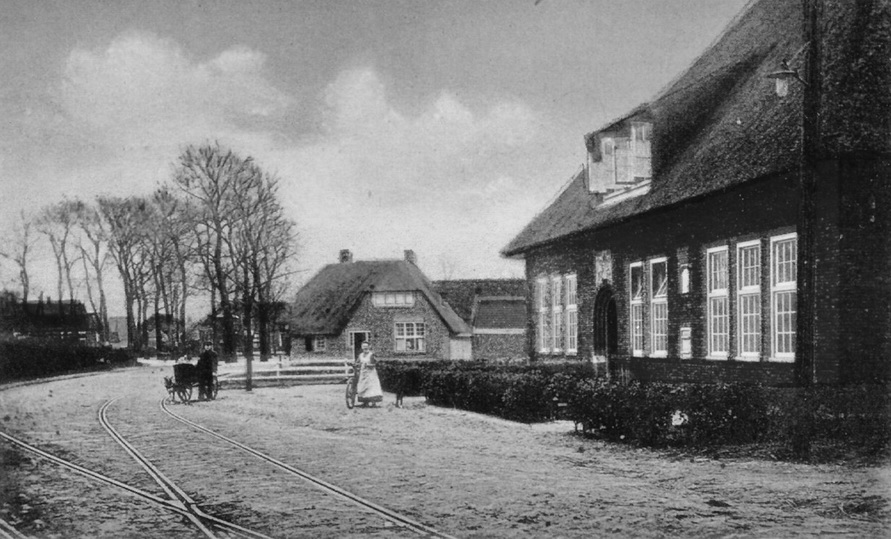
The crossing of the tracks just before the post office. The tracks were reverted to single track towards Torenlaan and Huizerweg.
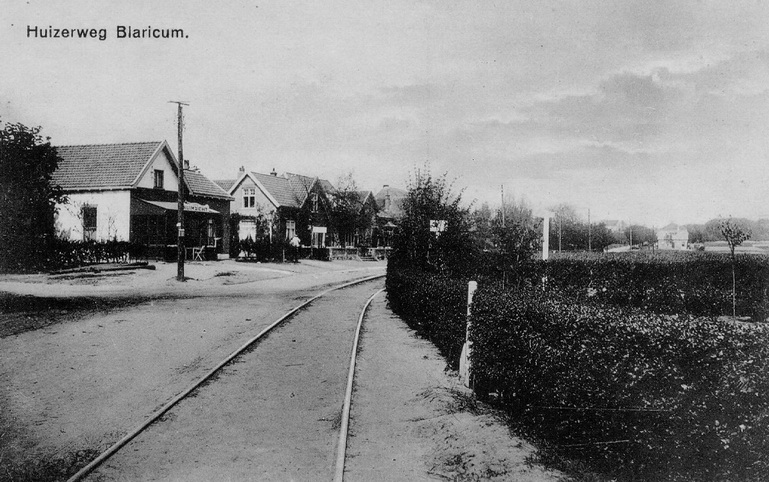
Huizerweg with Ruimzicht on the left, now Bellevue.
On Saturday, August 1, 1914, the mobilization period began, and regular passenger transport was subordinated to the transport of soldiers to the Naarden Fortress and the army camp at Crailo.
After the war, the first step towards modernization was the conversion of a steam motor vehicle; the steam engine was replaced by a gasoline engine. The test run in October 1924 was a success, and eight motor vehicles were ordered. On December 10, a full motor tram service was introduced on the Hilversum-Huizen line. This marked the end of the steam tram service in the Gooi region; steam trams were only used for additional journeys.
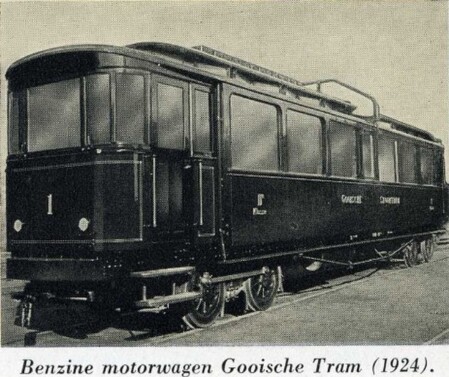
The GTM office was located in an old farmhouse that later housed the Mill garage. A small station building was built in the center of Blaricum, but it had to be moved after just two years.
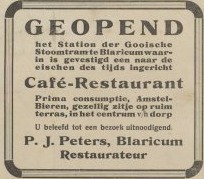
Here's a photo from local newspaper BEL of April 30, 1926.
The station building in Blaricum was "rolled" for the benefit of Mr. J. Vos, who had purchased a farm on the corner of Dorpsstraat and Meentweg, as well as the adjacent plot of land where the station stood. The haberdashery "De Vos" was built on the vacant land.
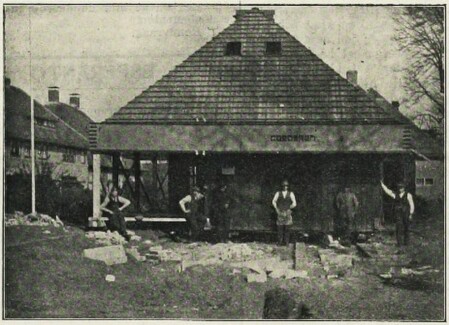
The management of the Gooische Stoomtram also wanted to replace the steam trams with motorised vehicles on the Amsterdam-Laren main line, but feared the required investment. Moreover, competition had emerged from the "Gooi-Express," a bus service operated by the Jaarsveld brothers. And in Hilversum, the former station master of the Dutch Railways (NS) had started a bus service between Hilversum and Bussum, which was prospering.
The management appealed to the municipality of Laren, arguing that a good mass transit service in the Gooi region was impossible with competition from the Gooi-Express. The Ministry of Public Works also intervened, and at the end of September 1930, the Gooi-Express discontinued its services.
Below is an article that appeared in the local newspaper Bel on November 15, 1929.
………………………………………….
THE GOOISCHE STOOMTRAM.
The previous Minister of Public Works had determined that the Amsterdam-Hilversum Gooi Express bus service should be discontinued six months after the Gooische Stoomtram had been modernized to his satisfaction. The management of the Gooische Stoomtram informed us at the time that they hoped to complete the modernization by November 1st. Upon inquiry, they have now informed us that the German factory was unable to deliver the new cars on time. Four or five gasoline-powered railcars will be put into service on December 15th.
In addition to the above report, we can provide the following information about the interior of the new cars:
They have a central balcony where passengers board and alight. Each side has a compartment, one for smoking and one for non-smoking. The single-class fare will be introduced. In an economically operating company, it is unacceptable for a section of a tram-train to be overloaded while another section is almost empty of passengers. Therefore, the new carriages have only one class, which has been adapted as closely as possible to the existing first class, so that one could say that the second class has disappeared.
The carriages, which are 14.80 meters long, contain forty seats and a maximum of sixteen standing places. They are powered by a six-cylinder gasoline engine that develops 150 horsepower at a maximum speed of 1,000 rpm, or double the power of the engines in the current railcars. The engine is also located almost entirely under the carriage. In the center, four heavy consoles are mounted to a spring-loaded window on which the engine components are mounted.
The higher-projecting engine components emerge from the center balcony, where they are integrated into a cabin and thus hidden from view. The cars are equipped with electric lighting, and the interior can be heated by the engine's cooling water. All cars are equipped with the Knorr braking system, which is also being installed on the trailers of the Gooische Stoomtram, whose appearance will also be matched to that of the new motor cars.
…………………………………………….
In 1929, 10 large motor cars had already been purchased, and on January 16, 1930, the large motor cars were introduced on the Laren-Amsterdam line.
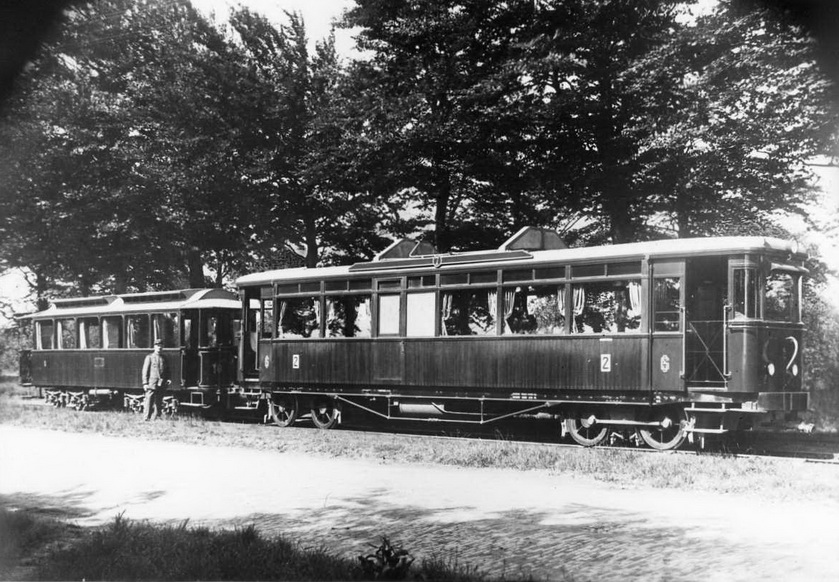
A petrol engine car with an older steam tram following car
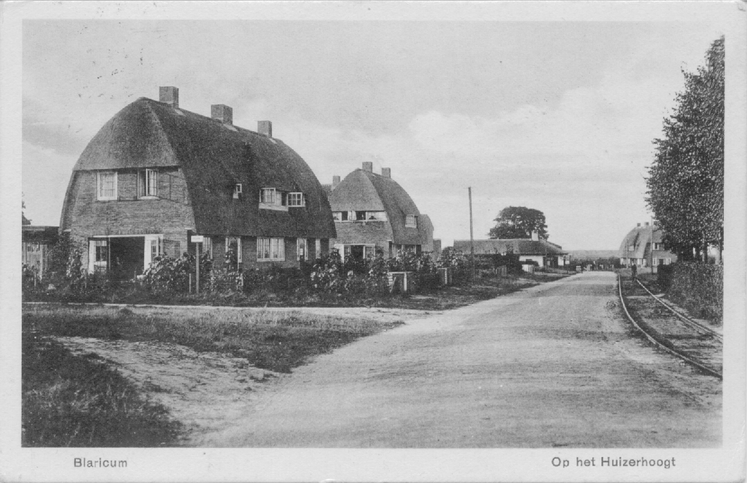
Huizerhoogt in 1932; looking towards Huizen from Atelierweg
The economic crisis of the 1930s necessitated more efficient operations; gasoline prices had risen sharply. In 1933 and 1934, gasoline engines were replaced by diesel engines in small railcars, and in subsequent years, in large railcars as well.
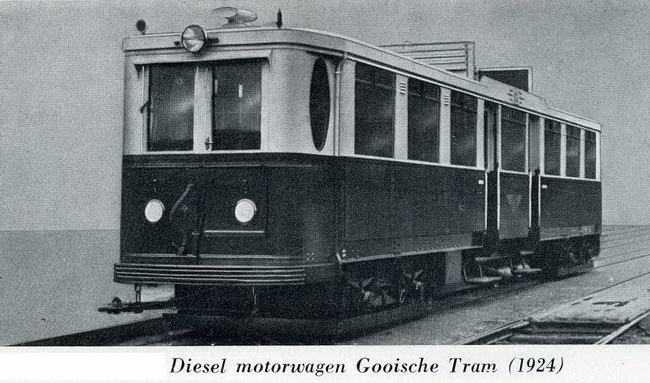
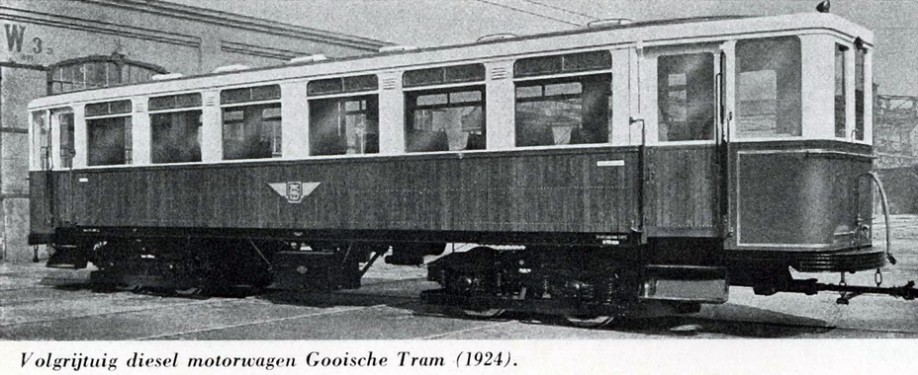
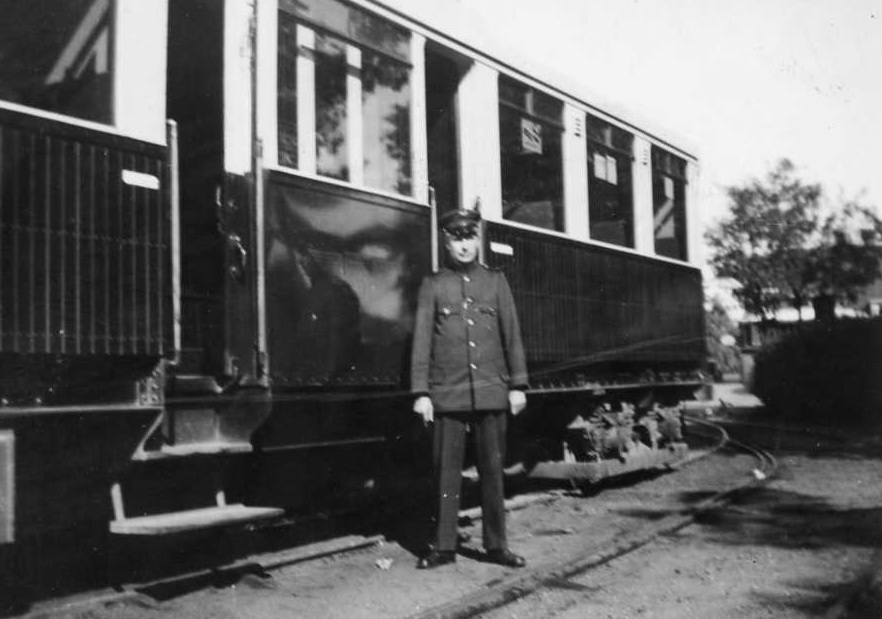
Driver Dirk Voerman at his tram.
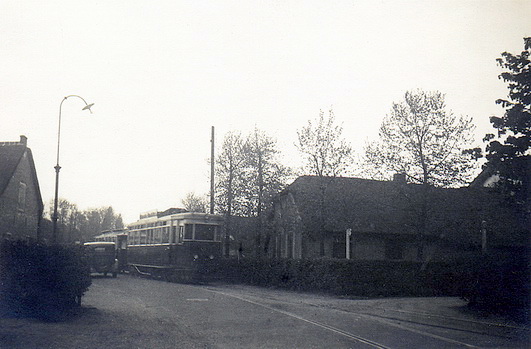
Motor vehicle on the Huizerweg opposite Achterom in 1937
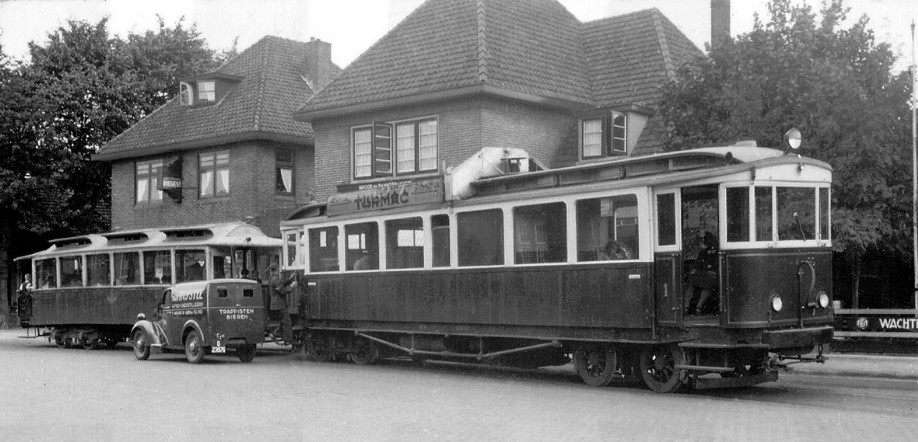
The tram, shown here as a diesel-powered vehicle, stops at the waiting room on Huizerweg. Photo from 1938
In 1938, the Directorate-General for Public Works and Water Management (Rijkswaterstaat) wanted to sacrifice the tram tracks to allow for the widening of Rijksweg 1. Despite protests from the management of the Gooische Tram, the Minister decided that year that the tram should be replaced by a bus service.
On June 5, 1939, the Hilversum-Laren-Blaricum-Huizen-Amsterdam bus service began. Twenty-two Mercedes-Benz buses were purchased for this service. The last tram to Laren ran on October 15, 1939.
With the outbreak of World War II and the rationing of gasoline and diesel, a very limited timetable was maintained. A limited steam tram service in the Gooi region was established on the remaining tracks via Amersfoortsestraatweg and Crailoo. By order of the Wehrmacht, the track via Crailoo was dismantled and replaced on the Blaricum-Huizen route.
Laying the rails on Torenlaan in 1942
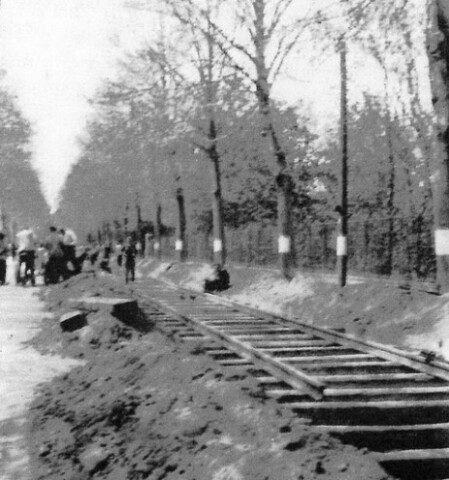
And so, in 1942, the Hilversum-Laren-Blaricum-Huizen-Bussum route was once again served by the steam tram.
But 1943 marked the end of the "Gooische Tramweg Maatschappij" (Gooische Tramway Company). As of December 31, 1943, the company ceased to exist due to a merger, which saw the entire Gooische tramway company absorbed into the "Nederlandsche Buurtspoorweg Maatschappij" (Dutch Local Railway Company) of Zeist, abbreviated to NBM.
During the war years, there was a rolling stock shortage, so several locomotives were leased from the Dutch Railways (NS). These locomotives had been used by the NS for shunting work and were actually too heavy for the tram's light gauge.
The photo next to this text shows Loc NS 8109 at the waiting room in Blaricum.
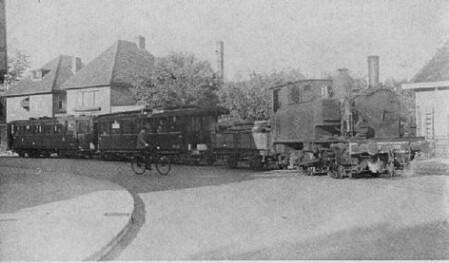
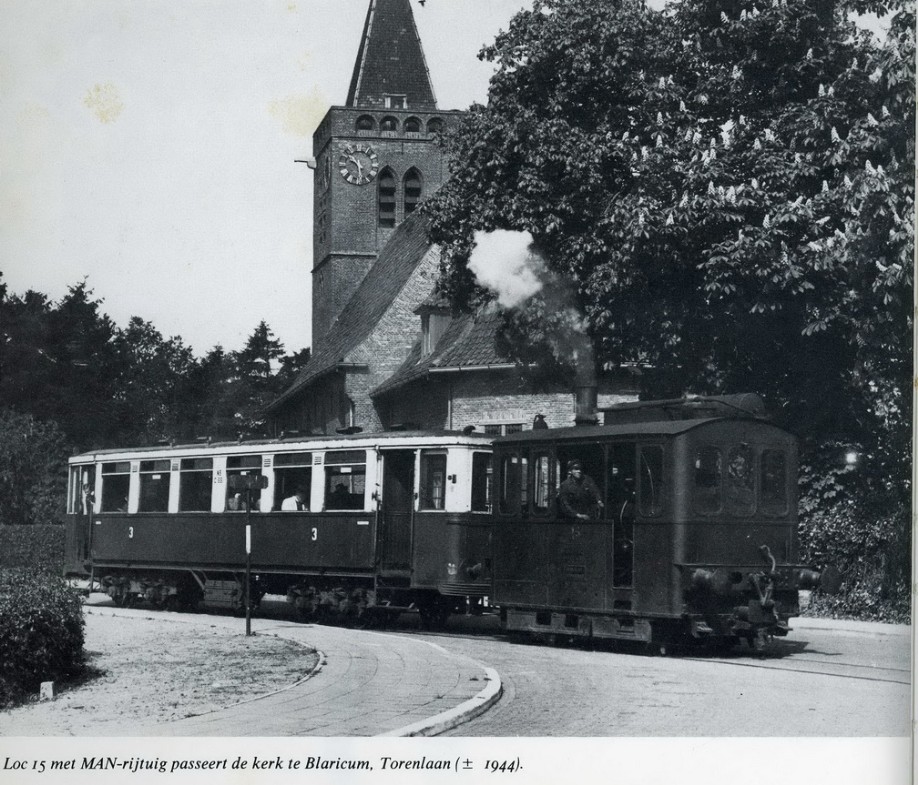
An old steam carriage during the war years, passing the Reformed Church in Blaricum (1944).
When the war ended, all the equipment had to be inspected and repaired if necessary. The buses were readied for scheduled service again. On August 14, 1945, there was a celebratory steam tram ride in the Gooi region.
Dirk Voerman, the oldest engineer with 39 years of service behind him, stood on the footplate of locomotive 16.
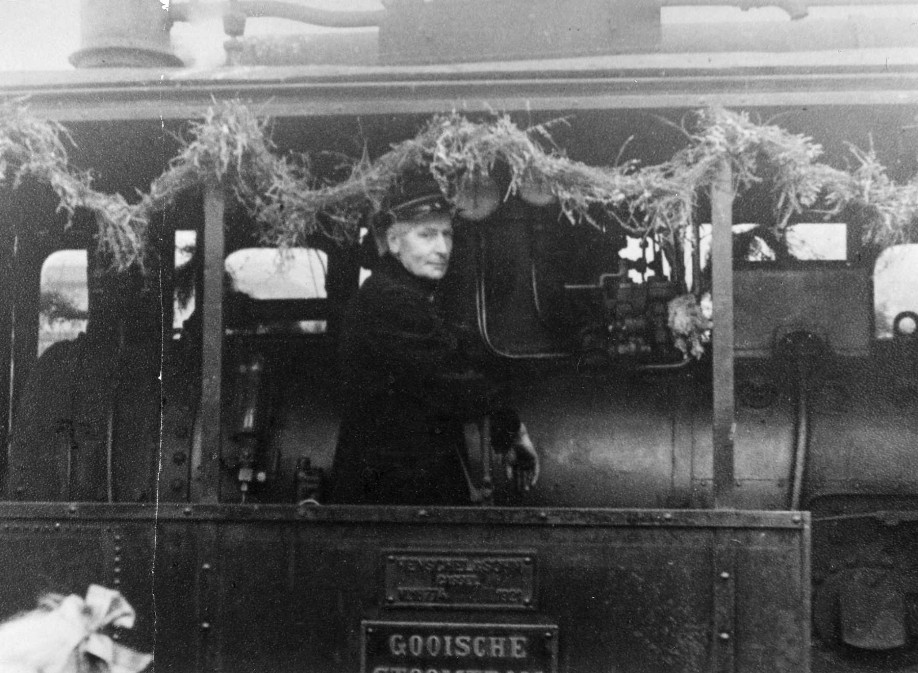
He joined the N.V. Gooische Stoomtram on November 1, 1905, as a workshop assistant. He then worked his way up from apprentice to engine driver.
When the motor trams arrived, he became one of the first drivers on the Gooische circular line between Hilversum, Huizen, and Bussum. After five years, he switched from the Gooische line to the Laren-Amsterdam route and remained loyal to the motor trams until they were replaced by buses in 1939. But when the war broke out, Dirk Voerman was able to return to his work on the steam locomotives.
Distinctive guests such as mayors and aldermen were seated in both carriages. People all along the line waved and cheered as locomotive 16 entered the Gooi region.
Upon arrival in Laren, a large wreath was hung on the engine, and the tram was showered with flowers. In Laren and Blaricum, it felt like Queen's Day.
Regular passenger tram service resumed the next day, August 15th. However, no service ran on Sundays. There was a locomotive shortage, so a large locomotive, the WSM-22, was rented from the Westlandsche Stoomtram Mij.
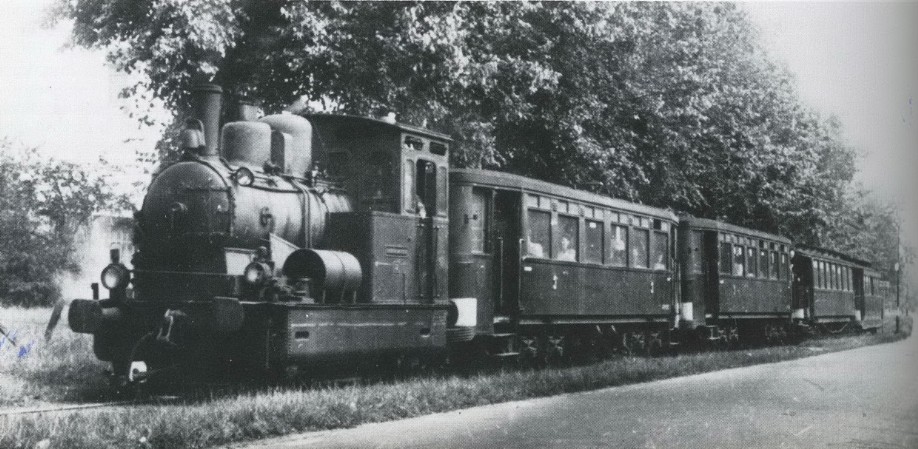
WSM locomotive 22 with 4 carriages in 1946
This powerful locomotive was used on the Gooi line for both passenger and freight trams until it was no longer needed in 1947 and returned to the Westland region.
The number of NBM buses steadily expanded, and the steam tram was displaced from the Hilversum-Laren route. The management decided to convert all tram lines to buses. The last passenger steam tram service in the Gooi region was on October 5, 1947.
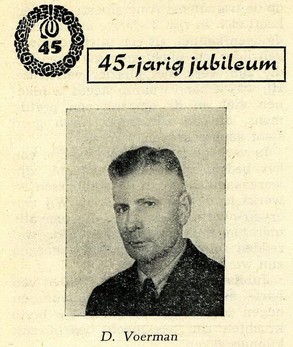 | 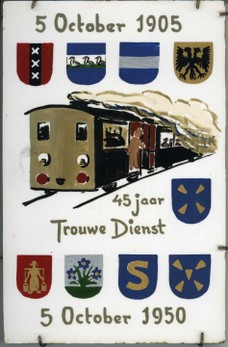 | 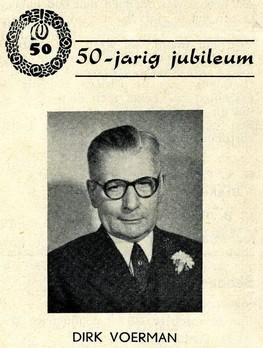 |
Dirk Voerman then went to work in the workshop/garage in Hilversum and celebrated his 45th anniversary in 1950. In 1954, he was awarded the Bronze Medal of Honor to the Order of Orange-Nassau, and in 1955, he celebrated his 50th anniversary.
Black-and-white film
Old film footage of the steam tram
A brief look back at the history of the NBM.
The NBM had its roots in the 19th century. On April 28, 1879, the Stichtsche Tramway Company opened the Utrecht-Zeist horse-drawn tram line.
Below is the open horse-drawn tram in Utrecht in 1900.
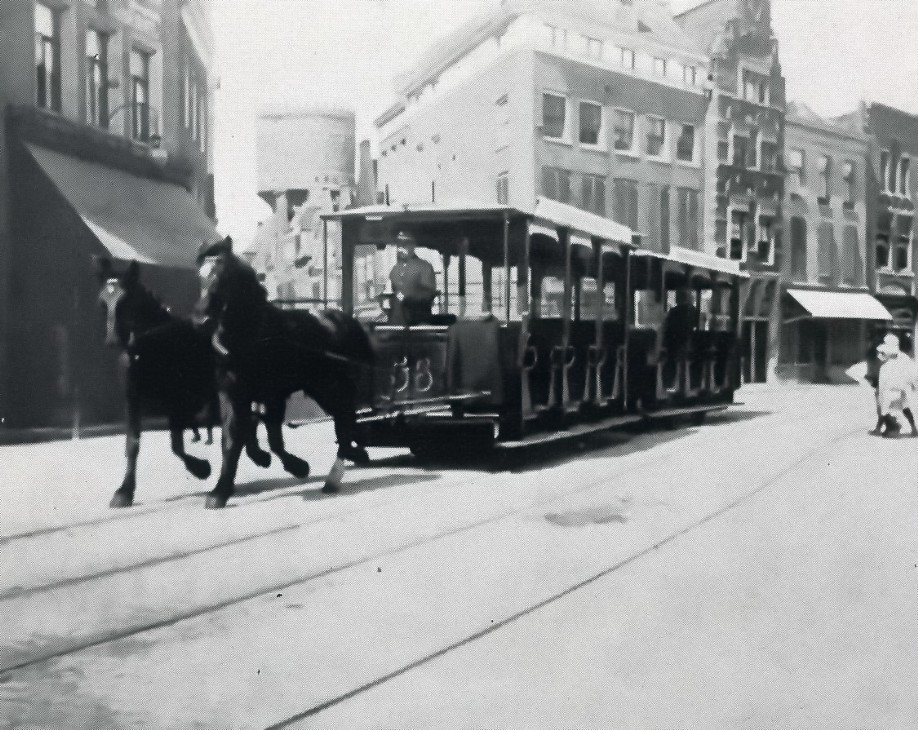
Through acquisitions of transport companies and private enterprises, the NBM grew into a large transport company that remained responsible for regional transport in 't Gooi. On January 1, 1944, the Gooische Tramweg Maatschappij (Gooi Tramway Company) was acquired.
On June 3, 1973, the NBM merged with the transport company Maarse & Kroon to form Centraal Nederland (Central Netherlands). In a merger on May 29, 1994, Centraal Nederland was divided into two parts. The Eastern Region (largely the former NBM area) merged with the Nieuwegein area of Westnederland and the VAD to form Midnet. The Western Region (largely the former Maarse & Kroon area) was incorporated into NZH.
With thanks to Wim van Manen—his grandfather was Dirk Voerman, a train driver with the GTM—and Martin van Doornik for information and photos about the Gooische Stoomtram.
